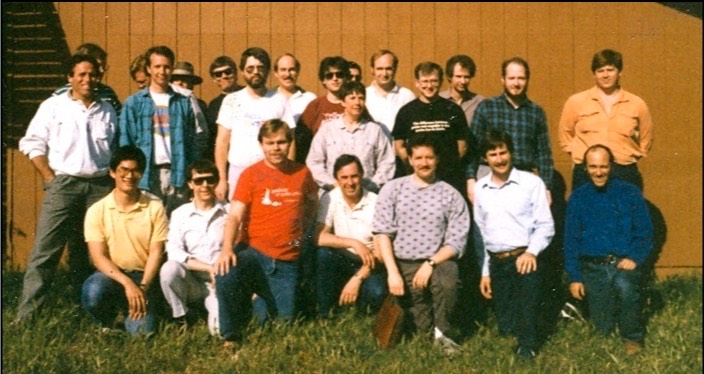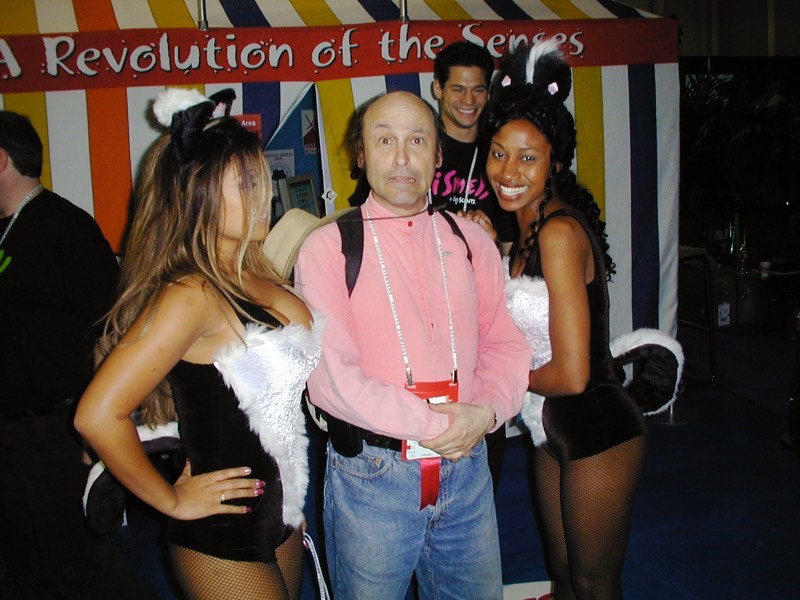August 14th, 2010
I founded the Computer Game Developers’ Conference. It all started back in 1987; I had started publishing the Journal of Computer Game Design and Nicky Robinson suggested that I put together a little conference for game developers. I announced the conference in an issue of JCGD and we held it in April 1988. Here’s a photograph of the attendees of that first conference:

Top Row, from left:
Sean Barger, unknown, Dave Menconi (hat), Cliff Johnson (sunglasses), Dan Howlett, unknown, Tim Brengle (white shirt), Tim Fredenburg
Middle Row, from left:
Stephen Friedman, Kellyn Beeck, unknown, Brian Moriarty (red shirt), Carol Manley (in front of Brian Moriarty), Gordon Walton (black shirt), Thurston Searfoss, unknown
Bottom Row, from left:
Gilman Louie, unknown, Jeff Johannigman (red shirt), Ivan Manley, unknown, unknown, Chris Crawford
Known Attendees whom I cannot recognize:
Mike Duffy, David Graves, Sean Hill, Dan Howlett, Jeff Jones, Michael Jones, Oran Kangas, Rob Swigart, Norman Worthington
Not in photo but attended earlier:
Brenda Laurel
That first conference was held at my home in the hills above San Jose. You can read the report I wrote for it afterwards here. It was such a big success that everybody asked me to do it again, and several people volunteered to assist. So I put together a group to build a bigger conference. That group consisted of me as chairman, Stephen Friedman, Brenda Laurel, Dave Menconi, Jeff Johannigman, Stephanie Barrett, and Tim Bringle. The six of us set up a conference just six months later, in September of 1988. We held it at the Milpitas Holiday Inn and it was a great success: 127 people attended. For me the highlight of the conference was an informal discussion of some of the top game designers in the world gathered around some lounge chairs.
After that second conference, we realized that this was going to be a success, so we decided to incorporate and be all legal. We all agreed on the basics: this was to be a public service, not a profit-driven conference, and board members were to derive no financial benefit from their service. Our treasurer, Stephen Friedman advised us that it would be impossibly difficult for us to incorporate as a non-profit corporation, and we took him at his word. In this, we made a colossal blunder that later caused much pain to all of us. We were legally for-profit but spiritually non-profit. That disjunction would cost us. We should have gone one way or the other, not try to mix them together. Even though I was at the moment the sole owner of the Computer Game Developers’ Conference, I felt it important that all members of the board feel equal, so we distributed all stock equally, with the proviso that stock ownership lasted only as long as a person remained on the board; on departure, a board member had to surrender their stock. This too was a blunder that we would come to regret deeply.
Our third conference came in the spring of 1989, and after that we settled on annual conferences in the spring. Attendance grew by at least 50% each year, and the headaches of handling ever-larger groups became serious. Just after our fifth conference, we had an internal dispute that caused two of our number to depart: Brenda Laurel and John Powers. I must accept responsibility for this failure, because the dispute revolved around my possessiveness of the conference. Other people wanted the chairmanship, and while I was happy to surrender other powers, I did not want to give up the central role on the board. If I were a better man, I could have resolved the dispute to everybody’s satisfaction, but I screwed up and lost two talented and motivated board members.
We had to find new members, and after some searching, we found five new members: Nicky Robinson, Anne Westfall, Susan Lee-Merrow, Sara Reeder, and Ernest Adams. Steven Friedman left shortly afterwards, leaving us with eight board members. I did some minor reorganization, and we proceeded to prepare and deliver ever-bigger conferences.
But our success would be our doom. We had always strove to keep the price of the conference low: the first was free, the second was $75, the third was $125, and so on. Each time, we found the conference inundated with wannabees -- people who weren’t professional game designers but desperately wanted to be. While we were happy to provide education for this group, we wanted to insure that it didn’t overwhelm the professionals. So we kept raising the price to chase them away. But what were we to do with all that extra money? We decided to provide better services to the attendees. A banquet dinner was part of the conference, but we later added free lunches and then free ice cream, soda, and cookies in the afternoon. Even though we kept spiffing up the conference, we couldn’t keep our accounts balanced: we were accumulating more and more money. So we decided to provide board members with any equipment they needed. Then we decided to permit board members to hire contractors to do some of the labor. And it was here that we lost our way.
The free equipment began to be regarded as an automatic right rather than a useful aid. I recall one board member asking if we could purchase a new computer for her. I asked if her computer was failing. No, the board member replied, she wanted it for her daughter. The board voted against providing the computer -- but it was a close vote. Contracts for labor were handed out to good buddies, not on the basis of any bidding or comparison of costs. The next thing I knew, we were paying ourselves a small fee -- a few hundred dollars, I think -- for our services to the conference. But the first real crack came when we hired a permanent part-time assistant. There was lots of dumb work that needed to be done. For example, advance registrations had to be entered into the database and the payments recorded. This was not a big deal when we had a few hundred attendees, but as we neared a thousand attendees, it became obvious that board members should not be doing this work. There were also lots of errands to run: delivering documents, placing and picking up orders with printers, picking up other supplies, and so forth. So the time had come to hire an assistant. Ernest Adams had a suggestion: his wife. She was available because she was out of work, and she was quite smart. However, on further discussion, it was revealed that she was having problems with carpal tunnel syndrome, so she really couldn’t do the data entry. Also, she had a bad back, so she couldn’t lift or carry things. As I saw it, this lady was the worst possible candidate for the job. But the argument that clinched it for the others was that she really needed a job. So because they felt sorry for her, they voted to hire her!
Things went downhill from there. The wealth being generated by this conference was obvious for any board member to see, and greed began to creep into their minds. Realizing that our schizophrenic structure (legally for-profit, ostensibly non-profit) could no longer be maintained, I decided that we had to take the bull by the horns and adopt an openly for-profit structure. However, this had to be done fairly; I insisted that previous board members should share in the windfall. This was certainly the ethical thing to do but it was also extremely impolitic. The fair and reasonable way to distribute stock was to award a set amount of stock for each year of service. By this time, there were only two of the original board members left: Tim Brengle and myself. We would own the largest blocs of stock. The other existing members of the board would, in effect, have some of their stock taken away and given to the previous members of the board. They saw my proposal as a way of taking stock away from them -- and they had all the votes on their side.
So the board finally removed me from the chairmanship; they definitely did not want my kind of leadership! Realizing that I was on the way out, I came up with a counterproposal: I would buy them out. I offered them a flat payment of $1 million for all the stock. They refused my offer; so I asked them to buy me out at the same rate I was offering to them. Clearly, if $1 million for six people was too low an offer, then $166K for one person (me) would surely be a bargain. But they refused that offer as well. Instead, they simply voted me out and confiscated my stock. They tried to run the conference but without my leadership, they simply couldn’t meet deadlines or get things done without furious arguments. The conference they delivered was a disaster. So they accepted an offer to sell the conference for $3 million. They offered $3,000 to previous board members to keep them from suing. I could have sued them the moment they confiscated my stock, but I had refrained from doing so because I didn’t want to distract them from their work on the conference. But the next year their lawyer tried to pull a sneaky trick, and I had to file suit before a critical legal deadline came. After stonewalling me for over a year, they settled within 24 hours of my filing suit. Being an overly ethical fool, I chose to settle for the same price I had offered them previously: $166K. Moreover, in the spirit of compromise and to hurry along a settlement, I had halved that figure. For various tax reasons, the final payment I received was $98K. Each of them received something over $500K.
I have left out many details of what was truly a twisted tale. Some of those details put me in a bad light; others put me in a good light. Some of the details put the other board members in a bad light; I don’t think any put them in a good light. This version of the tale certianly contains no falsehood and I think it represents a fair characterization of the entire fracas.
Under its new owners, the collegial atmosphere that had characterized the conferences I ran was replaced by a purely commercial atmosphere. Here’s a photo of me at the conference some years later:

What have they done to my conference?
